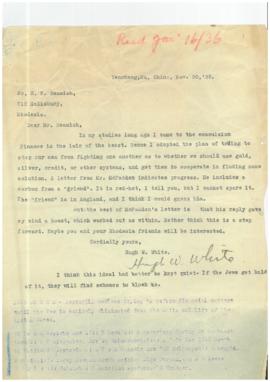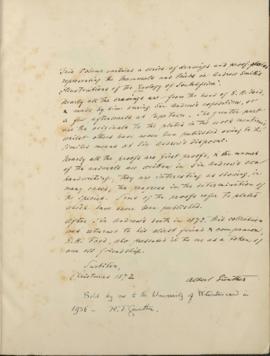Religious booklets, catechisms in various African languages, prayer books etc
- ZA HPRA AB2409-N
- Series
Including the following:
- Lipina ta Thoholetso, compiled/edited by J.P Mohapeloa, first ed. 1975. Contains hymns and choruses with musical notation in tonic solfa. Northern/Southern Sotho?
- Catechism for use in South Africa (no. 4, twenty-third edition, revised), n.d. English
- The Revised Catechism, 1962. English
- The Revised Catechism (South African Edition, revised 1965), 1962. English
- Catecismo em Shangaana (Diocese dos Libombos) = Provincial Catechism, 1941. Shangaan
- Katekisma (Diocese dos Libombos Missào Anglicana) = Provincial Cateshism, 1930. Gi-Tonga
- IKatekisma leChurch leProvince laseSouth Africa = A Catechism in Zulu, 1927. isiZulu
- Matšohlo A Lentsoe Le Halalelang La Molimo: Testamente E Ncha, 1912. Northern/Southern Sotho?
- Katekisma Ea Lithuto Tsa Religione Ea Bokreste, 1916. Northern/Southern Sotho?
- Lipaki tse Mashome a Mane tsa Sebaste, Kedemunde Mohalaleli, Joanna oa Fora, Mohalaleli = Lives of the Saints in Sesuto No. 1, 1922. SeSotho?
- Katikizima ya Sangano re Province of South Africa = Provincial Catechism in Unified Shona, 1934. Shona
- A Catechism of Christian Faith and Practice with Appendix and Private Devotions sanctioned for use in the Diocese of Bloemfontein (3rd edition), n.d. English
- Lumen ad Revelationem Gentium compiled by the Missionaries of the Church of England in Corea (translated into Chino, the language of Mashonaland), 1901. ?
- An Alternative Form of the Order for the Administration of the Holy Communion translated into Chinyanja for the use of Nyasa Christians = Missa Yoyela, n.d. Chinyanja
- Kuwomba ka Nkulukumba (Diocese dos Libombos) = Private Devotions in Chopi, 1937. ?
- Bernard Mitzeki, Teresa Mohalaleli, Perpetua le Felicitas, Bahalaleli = Lives of the Saints in Sesuto No. 6, 1922. SeSotho?
- Dorotea Mohalaleli, Kuthbert Mohaleleli, Lipaki tsa Uganda = Lives of the Saints in Sesuto No. 3, 1922. SeSotho?
- An Alternative form of the Order for the Administration of the Holy Communion (South African Edition), 1950. English
- Tsela ea Poloko; Buka ea Bobeli Lithuto tsa ñoaga sa bobeli, 1919. ?
- Hinos em Xironga = Hymn book in XiRonga, 1938. ?
- Matšotlo a Lentsue le Galalelang la Molimō (Testamente e Ncha), 1881. ?
- The Book of Ruth, 1936. English
- Puku ya Ditirêlô, 1949. English?
- Izinkonzo Nezimiso Zemitandazo Ezinye = Occasional Offices in Zulu, 1925. English
- Merapelo le Liletani le Lifela = Prayers, Litany, and Hymns in Sechuana, 1898. Sechuana
- Kanuni za Kuimba; i. Missa: Sehemu ya Watu, 1924 (Magila). ?
- Oração comum Hinário em Ronga (Diocese dos Libombos), 1947. ?
- The General Missionary Conference of South Africa: Commission 1, Uniformity and Discipline, n.d. English
- Litirelo tse li Siamtseng Metlha Mengoe, 1917. ?
- Incwadi yemibuzo (Diocese of St John’s, Kaffraria), 1902. IsiXhosa/IsiZulu
- Ikhatekhizima Elingasetshenziswa eChurch leProvince laseNingizimu yeAfrika lapho livunyelwe nguMbishobi, 1948. ?
- Indlela yesiphambano = Stations of the Cross, n.d. IsiXhosa/IsiZulu
- Hlaloso ea Liepistole tse Ling tsa Moapostola Pauluse 1 le 2 ba-Thessalonika ba-Filippi, Ba-Kolosse, 1907. Northern/Southern Sotho
- Teaching About God Book Two: Lessons on the Bible for Catechumens, n.d. English
- Indhlela Yokusindiswa Incwadi yokuqala Izifundo zonyaka wokuqala, 1918. ?
- Sala Fupi za Kanisa, 1928 (Zanzibar). KiSwahili
- Masomo ya Kwanza, Sehemu ya Kwanza = First Swahili Reader, n.d. KiSwahili
- Devocionário Ronga – Private Devotions in Xi-Ronga, 1940. ?
- Tsamba Yecipiri = Shona Second Reader, 1933. Shona
- Tsamba Yecitatu (The “Rusape” Reader) = A Third Reader in United Shona, 1934. Shona
- Zwidzidzo Zwe Kudzidzisa awo wari kugadzirira rabupatidzo runoyera, 1931. ?
- Tsela ea Poloko Lithuto ysa Selemo sa Bobeli = Catechism in Sesuto, n.d. Northern/Southern Sotho
- Interpreting the Bible to this Generation, by Leonard N. Fisher (Bishop of Natal), c.1945. English
- Report of a Conference of the Heads of Theological Colleges held at St Peter’s Priory, Rosettenville, April 10–12, 1934, n.d. English
- Paki, No. 28/29, Selemo 1959. ?
- Department of Public Education Cape of Good Hope: Religious Instruction in Denominational Public Schools, 1945. English
- Mohkoa oa ho Etsa Komunione e Halalelang o Ka Sebelisoang Sebakeng sa Mokhoa oa Khale = The Alternative Liturgy of the Church of the Province of South Africa in the Sesuto Language, 1926. Northern/Southern Sotho?




